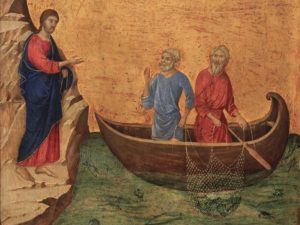I will make you fishers of men
Mount Calvary Church
Eutaw Street and Madison Avenue
Baltimore, Maryland
A Roman Catholic Parish of
The Personal Ordinariate of St. Peter
Anglican Use
Rev. Albert Scharbach, Pastor
Dr. Allen Buskirk, Choirmaster
Midori Ataka, Organist
Epiphany III
Sunday, January 26, 2020
8:00 AM Said Mass
10:00 AM Sung Mass
Brunch to follow in undercroft
__________________
Common
Merbecke
__________________
Organ Prelude
Choral in G major by Alexandre Guilmant
Organ Postlude
Lead, Kindly Light by Robert Powell
Anthems
Surge, illuminare, Jerusalem, William Byrd (1540-1623)
Surge, illuminare Jerusalem: quia venit lumen tuum, et gloria Domini super te orta est. Alleluia.
Arise, be enlightened, O Jerusalem: for thy light is come, and the glory of the Lord is risen upon thee.
“Surge, Illuminare” is typical of the densely written, detailed counterpoint of Byrd’s Latin motets. The opening figure for “surge” (meaning “arise”) spins rhythmically forward. Byrd maintains a driving quality that peaks in the swinging motive for the last phrase “super te orta est.” The fastest rhythms are saved for the highly imitative “alleluia.” Published in Byrd’s second book of Gradualia, this piece was the result of a mistake on Byrd’s part and therefore serves no liturgical function. He intended it as a setting of the Gradual for the Epiphany mass, but accidentally used a related text from the lesson of that mass rather than the correct Gradual text. Realizing his mistake, he moved this piece out of the sequence of the Epiphany mass to its final position in the Gradualia. Nevertheless, the sense of the text is appropriate for the Epiphany season, where we celebrate the coming of the light and the glory of the Lord.
Almighty and everlasting God, Orlando Gibbons (1583-1625)
Almighty and everlasting God, mercifully look upon our infirmities, and in all our dangers and necessities stretch forth thy right hand to help and defend us, through Christ our Lord. Amen.
Orlando Gibbons (1583-1625) was one of the great English composers between Byrd and Purcell, excelling in many idioms, including keyboard music, verse anthem for choir and organ, and especially music for viol consort. The text of “Almighty and everlasting God” is taken from the traditional Book of Common Prayer collect for the Third Sunday after Epiphany, read by the priest in today’s service after the Kyrie and Gloria. Gibbons pays particular attention to the musical shape of each line; listen, for example, to the syncopated entrance that pulls the line forward at the high point of the piece on the text “stretch forth thy right hand.”
Hymns
How bright appears the morning star is a translation by William Mercer (1811—1873 ) of Wie schön leuchtet der Morgenstern by Philipp Nicolai (1556—1608). The hymn is based on Psalm 45, a wedding song and on Revelation 22:11. Nicolai, a Lutheran minister, wrote in 1597, during a terrible pestilence, when he saw thirty parishioners a day buried under his window. The original version of the hymn uses the extravagant language of bridal mysticism, but William Mercer changed it into a sober celebration of God’s love and power, manifested in the Incarnation. Adapting a tune written for Psalm 100 found in Wolff Köphel’s Psalter (1538), Nicolai composed the tune WIE SCHÖN LEUCHTET, which was published with the text in 1599.
Lead, Kindly Light (LUX BENIGNA). Newman write this while sick and becalmed at sea in June 1933. Angry at the state of disunion and supineness in the Church he still loved and in which he still believed; confident that he had ‘a mission,’ ‘a work to do in England;’ passionately longing for home and the converse of friends; sick in body to prostration, and, as some around him feared, even unto death; feeling that he should not die but live, and that he must work, but knowing not what that work was to be, how it was to be done, or to what it might tend, he breathed forth the impassioned and pathetic prayer, one of the birth-pangs, it might be called, of the Oxford movement of 1833. LUX BENIGNA was composed by John Bacchus Dykes (1823-1876).
Christ, whose glory fills the skies was written by Charles Wesley (1707—1788). He begins the hymn with the antithesis between light and night. In stanza two, Wesley uses the first words of each line to tell the story of redemption. The first three lines begin with “Dark,” “Unaccompanied,” and “Joyless.” The plight of humanity has been set. The next two lines begin with “till” which represents hope for salvation. The repeating of “more and more” implies the idea that we can never see enough of the “Radiancy divine” which has “[pierced] the gloom of sin and grief.” Scripture references are present throughout: John 1:9,the “true light”; Isaiah 2:6 and Malachi 4:2, the “Sun of Righteousness”; Isaiah 14:12 and 2 Peter 1:19, the ”Day Star.” The tune RATISBON is by Johann Gottlob Werner (1777-1822).
